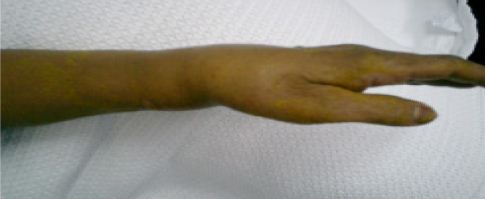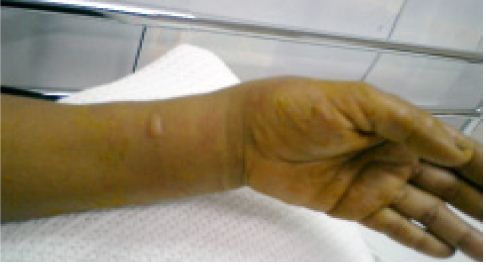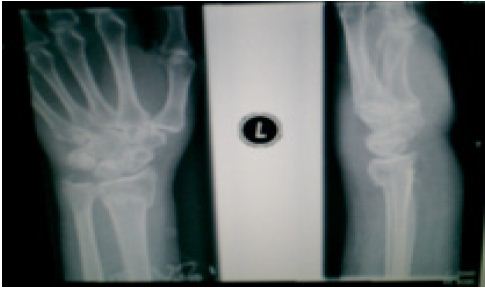Complications of Hot Tumeric Use in Acute Trauma
Ammar Al-Kashmiri,1 Mohammed Al-Mutani,2 Anwar Al-Zadjali1
doi:10.5001/omj.2010.71
ABSTRACT
The use of hot Tumeric paste for treatment of musculoskeletal injuries is a home remedy commonly used in Oman. This practice occasionally leads to skin burns complicating an already injured extremity. This case report discusses the uses of Tumeric as a medicine as well as the management of the complication arising from its improper use as illustrated in this case.
From the 1Emergency Department, Khoula Hospital, Muscat, Oman, 2 Orthopedics Department, Sultan Qaboos University Hospital, Muscat, Oman
Received: 11 Feb 2010
Accepted: 02 Apr 2010
Address correspondence and reprint request to: Dr. Ammar Al Kashmiri, 1Emergency Department, Khoula Hospital, Muscat, Oman.
E-mail: ammar.k@moh.gov.om
INTRODUCTION
The use of turmeric as a traditional medicine is a popular practice in the Sultanate of Oman. It is used mostly as a topical agent in the management of different ailments including musculoskeletal injuries. This case report aims to illustrate the potential hazard when this remedy is inappropriately used. It is not uncommon to see patients presenting to the Emergency Department with a burn on an already injured extremity as a complication caused by the use of hot turmeric. We present a case of a fracture of the distal end of the radius with a second degree burn to the overlying skin. Discussed are the effects of turmeric, the management of the case and recommendations.
CASE REPORT
A 38 years old female, who looked much older than her stated age, presented to the Emergency Department with complaints of pain and swelling of her left wrist. The patient had sustained a mechanical fall at home where she slipped while trying to pick something off the floor. She sustained the fall from her own height and landed on an out stretched hand. She gave no history of any preceding symptoms and there was no history of associated head trauma. The patient denied any past medical history of significance and she had no reported allergies. She was treated at home with a traditional remedy where a paste of hot turmeric mixed with water and salt was directly applied to her wrist. She immediately felt an increase in pain and the swelling appeared to increase. She sought care in the Emergency Department one hour after the fall.
On examination, the patient was in pain. Her vital signs were all within normal limits. On examining her left upper extremity, she had evidence of gross swelling of her wrist with dinner fork deformity. (Fig. 1)
There was also redness with two small blisters on the volar aspect of her left wrist, (Fig. 2). Her distal pulses were normal and there was no evidence of neurological deficits in the extremity. The rest of her physical examination was unremarkable.
Figure 1: Classical “dinner fork” deformity of Colle’s fracture.
Figure 2: Second degree burn with signs of redness and blistering over the volar aspect of the left wrist.
Figure 3: AP and lateral X-ray views of the wrist showing a Colle’s type fracture.
The clinical impression was a Colle’s fracture with first and second degree burns of the skin overlying the fracture. X-rays of the wrist obtained in anteroposterior and lateral views confirmed the presence of a fracture in the distal end of radius with dorsal displacement, dorsal tilt, radial displacement and radial tilt. (Fig. 3)
With the use of Procedural Sedation, the area was cleaned and the blisters were debrided. A dressing was applied with Silver sulfadiazine over the burn area, after which a closed reduction of the fracture was performed and a backslab was applied to the extremity. The patient was instructed to keep the limb elevated and she was given oral analgesia and advised to report back to the Emergency Department if the pain and swelling worsened. The patient was referred to the fracture clinic for follow-up and application of full casting after the edema had subsided.
DISCUSSION
Turmeric is an Indian spice that comes from the root of the Curcuma longa plant that has a tough brown skin and a deep orange flesh. It was traditionally called Indian saffron because of its deep yellow-orange color. In Ayurvedic medicine, turmeric is a well-documented treatment for various respiratory conditions (e.g., asthma, bronchial hyperactivity, and allergy) as well as for liver disorders, anorexia, rheumatism, diabetic wounds, runny nose, cough, and sinusitis. In traditional Chinese medicine, it is used to treat diseases associated with abdominal pain. In ancient Hindu medicine, it was used to treat sprains and swelling.1
Throughout the World, it has traditionally been used to good therapeutic effect, particularly as an anti-inflammatory, and many of its therapeutic effects have been confirmed by modern scientific research. Such effects include antioxidant, anti-inflammatory, anticarcinogenic and antimicrobial, hepatoprotective, thrombosuppressive, cardiovascular (i.e., as protection against myocardial infarction), hypoglycemic, and antiarthritic (i.e., as protection against rheumatoid arthritis).1-9
The major chemical constituent of turmeric is curcumin (diferuloylmethane), which constitutes up to 90% of the total curcuminoid content, with the remaining 10% consisting of demethoxycurcumin and bis-demethoxycurcumin.3,4 Researchers have revealed that the anti-inflammatory activity of turmeric is due to curcumin which can inhibit both the activity and the synthesis of cyclooxygenase-2 (COX2) and 5-lipooxygenase (5-LOX), as well as other enzymes which are implicated in inflammation.2-9 Although NSAIDS (such as celecoxib, aspirin, ibuprofen, phenylbutazole, etc.) have been approved for treatment of inflammatory conditions, they are all gastric irritants. In contrast, turmeric has both an anti-infammatory and a gastric-protective properties,10,11 which makes it a more appropriate option.
In Omani traditional medicine, the use of turmeric for musculoskeletal trauma is very popular. It is common to see patients from different age groups presenting to the emergency department with musculoskeletal trauma and a yellow discoloration over the affected area.
The turmeric is mixed with water and salt forming a paste which is then heated and directly applied over the injured area. Not uncommonly, patients present with different degrees of burns as a complication to the application of this hot paste. This is more commonly seen in the extremes of age. It is important to look for signs of burns as it changes the management priorities especially in the setting of fractures and dislocations where these injuries have to be reset. In this case, the patient presented with a fracture of the distal end of radius associated with second degree burn in the volar aspect of her wrist. Generally, treatment of burns takes priority followed by the fracture treatment. As the burns were not extensive in this case, the fracture was reduced and Silver sulphasalazine dressing was applied with the slab on top.
Although the debridement of blisters is controversial and there is a potential risk of introducing an infection, this case was managed by debridement to allow the application of the slab. In other cases where the burns are more extensive, the correction of the bony deformity may be delayed until the burns are healed as attempting closed reduction would further damage the burnt skin through manipulation and traction. Routine changing of dressings should be maintained and access to the burn area must be maintained through a window through the cast or splint whenever practical.
Although the anti-inflammatory effects of tumeric are well-documented, available evidence suggest a systemic effect when tumeric is ingested. In addition, there is evidence from non-human research that when turmeric is mixed with other compounds that act as vehicles, e.g. menthol, an anti-inflammatory effect is witnessed.9,12,13,14 This is necessary since Curcumin, the active ingredient in tumeric, is a hydrophobic chemical. It is not clear if the Omani traditional preparation is able to penetrate through skin and into deeper tissues. The heating of the paste and mixing with salt might be attempts to increase its penetration, however, this long-standing tradition is yet to be scientifically tested. The potential side effect of burning the skin makes whatever questionable benefit that might be obtained from the hot paste unjustified.
CONCLUSION
Hot turmeric paste is a popular home remedy. Although no
evidence supports the use of such preparation, it will likely continue to be commonly used as it is strongly believed-in, especially by the older generations. Because of the serious harm that can be caused by burning skin especially if it is overlying a fracture, health professionals must be active in educating the public about abandoning this practice especially since it is not supported by scientific evidence.
ACKNOWLEDGEMENTS
The authors reported no conflict of interest and no funding was received on this work.
-
Goel A, Kunnumakkara AB, Aggarwal BB. Curcumin as ‘‘Curecumin’’: From kitchen to clinic. Biochemical Pharmacology. 2008; 75(4):787-809. Epub 2007 Aug 19
-
Tieraona Low Dog. A Reason to Season: The Therapeutic Benefits of Spices and Culinary Herbs. Explore: The Journal of Science and Healing. 2006; 2(5): 446 -449.
-
Sharma RA, Steward WP, Gescher AJ. Pharmacokinetics and pharmacodynamics of curcumin. Adv Exp Med Biol. 2007; 595:453-70.
-
Vitetta L, Cicuttini F, Sali A. Alternative Therapies for Musculoskeletal Conditions. Best Practice & Research Clinical Rheumatology. 2008; 22(3): 499–522.
-
Maheshwari RK, Singh AK, Gaddipati J, Srimal RC. Multiple biological activities of curcumin: A short review. Life Sciences. 2006; 78(18): 2081–2087.
-
Khanna D, Sethi G, Ahn KS, Pandey MK, Kunnumakkara AB, Sung B, et al. Natural products as a gold mine for arthritis treatment. Current Opinion in Pharmacology. 2007;7(3): 344–351.
-
Aggarwal BB, Harikumar KB. Potential therapeutic effects of curcumin, the anti-inflammatory agent, against neurodegenerative, cardiovascular, pulmonary, metabolic, autoimmune and neoplastic diseases. The International Journal of Biochemistry & Cell Biology. 2009; 41(1): 40– 59.
-
Shishodia S, Chaturvedi MM, Aggarwal BB. Role of Curcumin in Cancer Therapy. Current Problems in Cancer. 2007; 31(4): 243-305.
-
Thomas-Eapen NE. Turmeric: The Intriguing Yellow Spice with Medicinal Properties. Explore: The Journal of Science and Healing. 2009; 5(2): 114-115.
-
Kim DC, Kim SH, Choi BH, Baek NI, Kim D, Kim MJ, et al. Curcuma longa extract protects against gastric ulcers by blocking H2 histamine receptors. Biol Pharm Bull. 2005; 28(12):2220-4.
-
Chattopadhyay I, Bandyopadhyay U, Biswas K, Maity P, Banerjee RK. Indomethacin inactivates gastric peroxidase to induce reactive-oxygen-mediated gastric mucosal injury and curcumin protects it by preventing peroxidase inactivation and scavenging reactive oxygen. Free Radic Biol Med. 2006; 40(8):1397-408. Epub 2006 Jan
-
Hegge AB, Schüller RB, Kristensen S, Tønnesen HH. In vitro release of curcumin from vehicles containing alginate and cyclodextrin. Studies of curcumin and curcuminoides. XXXIII. Pharmazie. 2008; 63(8):585-92.
-
Patel NA, Patel NJ, Patel RP. Design and evaluation of transdermal drug delivery system for curcumin as an anti-inflammatory drug. Drug Dev Ind Pharm. 2009; 35(2):234-42.
-
Patel NA, Patel NJ, Patel RP. Formulation and evaluation of curcumin gel for topical application. Pharm Dev Technol. 2009; 14(1):80-9.
How to cite this URL
Al-Kashmiri A, Al-Mutani M, A-Zadjali A. Complications of Hot Tumeric Use in Acute Trauma. OMJ [Online] 2010 July; 25(3). Available at http://www.omjournal.org/CaseReports/FullText/201007/FT_6ComplicationsofHot.html.


